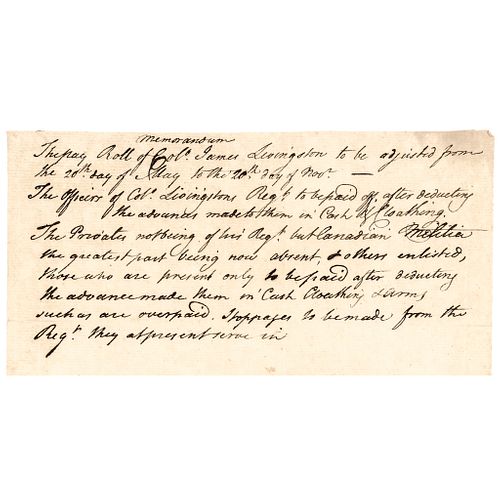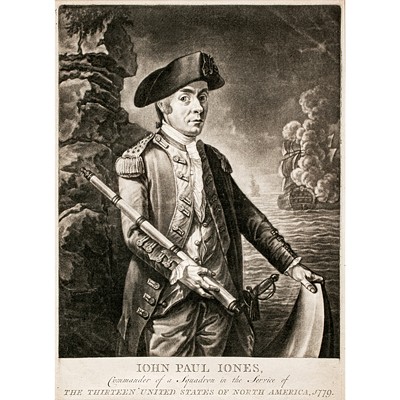c. 1776 Revolutionary War Document, First Canadian Regiment Pay Roll Adjustment
Lot 83
Categories
Estimate:
$1,800 - $2,400
Absentee vs Live bid
Two ways to bid:
- Leave a max absentee bid and the platform will bid on your behalf up to your maximum bid during the live auction.
- Bid live during the auction and your bids will be submitted real-time to the auctioneer.
Bid Increments
| Price | Bid Increment |
|---|---|
| $0 | $10 |
| $200 | $20 |
| $300 | $25 |
| $500 | $50 |
| $1,000 | $100 |
| $2,000 | $200 |
| $3,000 | $250 |
| $5,000 | $500 |
| $10,000 | $1,000 |
| $20,000 | $2,000 |
| $30,000 | $2,500 |
| $50,000 | $5,000 |
| $100,000 | $10,000 |
| $200,000 | $20,000 |
| $300,000 | $25,000 |
| $500,000 | $50,000 |
About Auction
By Early American History Auctions
Jan 23, 2021
Set Reminder
2021-01-23 12:00:00
2021-01-23 12:00:00
America/New_York
Bidsquare
Bidsquare : Early American History Auction of Autographs, Americana, Political & Maps
https://www.bidsquare.com/auctions/early-american-history-auctions/early-american-history-auction-of-autographs-americana-political-maps-6311
311 Lots of Rare, Historic Autographs, Americana, Civil War Era, George Washington, Abraham Lincoln, Slavery & Black History, Revolutionary War Era, Colonial America, Federal Period, War of 1812, Colonial Currency, Indian Peace Medals & more... Early American History Auctions auctions@earlyamerican.com
311 Lots of Rare, Historic Autographs, Americana, Civil War Era, George Washington, Abraham Lincoln, Slavery & Black History, Revolutionary War Era, Colonial America, Federal Period, War of 1812, Colonial Currency, Indian Peace Medals & more... Early American History Auctions auctions@earlyamerican.com
- Lot Description
American Revolution
c. 1776 "First Canadian Regiment - Memorandum" the Regiment that Aided In The Capture of Major Andre
c. 1776 Revolutionary War Dated, Manuscript Document, "Pay Roll Adjustment" for Livingston's "first Canadian Regiment," Choice Extremely Fine.
A very rare Revolutionary War dated Document from during the Canadian military campaign. Undated "Memorandum" written circa 1776 concerning "the pay Roll of Colo James Livingston to be adjusted from the 20th day of May to the 29th day of Novr." This original Manuscript Document, measures 6.25" x 7.75" being from Livingston's "first Canadian Regiment." It is intended to be raised out of Canada but dissolved after the American failures there. Boldly written in rich brown on extremely clean, crisp, high quality "PRO PATRIA" watermarked laid period paper, which has excellent eye appeal. This extremely rare Document specifies that, in full:
"Memorandum - (Titled) The Pay Roll of Colo. James Livingston to be adjusted from the 20th day of May to the 20th day of Novr. - The Officers of Colo. Livingstons Regt. to be paid off after deducting the advances made to them in Cash & Cloathing. The Privates not being of his Regt. but Canadian Militia the greatest part being now absent, & others enlisted, those who are present only to be paid after deducting the advance made them in Cash Cloathing & arms such as are overpaid. Stoppages to be made from the Regt. they at present serve in."
The 1st Canadian Regiment, was raised by James Livingston to support Colonial efforts in the American Revolutionary War during the invasion of Quebec. Livingston recruited men from Chambly, Quebec as early as September 1775, but a formal regimental designation was made by Richard Montgomery on November 20, 1775, with recognition by the Second Continental Congress following on January 8, 1776. The regiment, which never approached its authorized size of 1,000 men, saw action primarily in the Canadian theater and New York, and was disbanded on January 1, 1781 at King's Ferry, New York (see added information on our website). First we have offered regarding the First Canadian Regiment, and in remarkable quality.
The 1st Canadian Regiment, was raised by James Livingston to support Colonial efforts in the American Revolutionary War during the invasion of Quebec. Livingston recruited men from Chambly, Quebec as early as September 1775, but a formal regimental designation was made by Richard Montgomery on November 20, 1775, with recognition by the Second Continental Congress following on January 8, 1776. The regiment, which never approached its authorized size of 1,000 men, saw action primarily in the Canadian theater and New York, and was disbanded on January 1, 1781 at King's Ferry, New York.
In September 1775, colonial forces under the command of Philip Schuyler and Richard Montgomery crossed into the Province of Quebec with the aim of driving British military forces from Montreal and Quebec City. Guy Carleton, the British governor and military commander, had fortified Fort Saint-Jean as the primary defense of Montreal. The colonial forces, preparing to besiege the fort, sought local support. James Livingston, a grain merchant living near Chambly, about 10 miles (16 km) from Saint-Jean, raised a local militia, which in October assisted in the siege and capture of Fort Chambly, and the capture of supplies intended for the besieged moving on the Richelieu River.
Following the fall of Montreal, Livingston was authorized by Montgomery on November 20 to raise a regiment to assist in the coming assault on Quebec City. In eight days he raised approximately 200 men. The regiment received formal recognition from the Second Continental Congress on January 8, 1776.
The regiment at first consisted of a mix of French-speaking Canadiens, Acadians, and American colonials who had settled in Quebec after the British took control of the province.
Two of Livingston's brothers served in the regiment. Richard Livingston was a lieutenant colonel, and Abraham served as a captain.
When Montgomery's army arrived outside Quebec, the 1st Canadian consisted of two to three hundred Canadians. On December 31, 1775, the regiment was charged with making a diversion at Quebec City's Saint Jean gate, to draw British attention away from the primary attacks, which were led by Benedict Arnold and Richard Montgomery, and were directed at the city's Lower Town. The diversions did not work, and the battle ended disastrously for the Americans, with Montgomery killed, Arnold wounded, and about 400 men taken prisoner. (From Wikipedia)
The remnants of the army, then under Arnold's command, besieged the city until May 1776, when British reinforcements began arriving, forcing the Americans into a panicked retreat. The retreat ended at Sorel on May 20, where they were met by reinforcements, and eventually put under the command of General John Sullivan.
On the night of June 7, 1776, Livingston's regiment was part of a force of about 2,000 under Brigadier General William Thompson that returned from Sorel to Trois-Rivires to drive off what they believed to be 300 to 600 British troops from Quebec. When they arrived near Trois-Rivires, they instead found the vanguard of the British counteroffensive, numbering several thousand. After a brief skirmish, the Americans forces were broken, and made a disorganized retreat back to Sorel.
Following this battle, the regiment retreated with the rest of the army to Fort Ticonderoga. While the regiment had never been particularly large (Livingston never had more than a few hundred men under arms at any one time), the retreat from Quebec left the regiment much reduced in size, since anyone leaving the province was unlikely to be able to return.
Following the army's return to Ticonderoga, the regiment was assigned garrison duty in upstate New York, primarily the Mohawk and Schoharie valleys, so that it could be reorganized. During this time, Livingston was known to be recruiting in New York City. Following Burgoyne's invasion of from Quebec in 1777, the regiment was moved to the upper Hudson River valley. In August 1777, the regiment was assigned to Benedict Arnold on his expedition in relief of the Siege of Fort Stanwix. It then saw service in both Battles of Saratoga.
The regiment saw action in the Battle of Rhode Island in 1778. For the remainder of the war, the regiment had garrison duty in New York. Most notably, Colonel Livingston was in command of Verplanck's Point on the Hudson River in September 1780, and played a crucial role in the unmasking of Benedict Arnold's treachery. While on guard duty, his troops fired on the British sloop of war Vulture, forcing that vessel to retreat southwards. This ship had brought Major John Andr to meet with General Arnold, who was then in command at West Point. Since the ship was driven off, Andr was forced to attempt travel by land to New York, when he was captured not far from the British lines near Tarrytown with incriminating papers in his possession. Andr was hanged as a spy, and Arnold, his plot discovered, managed to escape to the British lines.
The regiment was disbanded as part of a major reorganization on January 1, 1781 at King's Ferry, New York. Members that remained in service were assigned to the 2nd Canadian Regiment.
- Shipping Info
-
Early American provides in-house worldwide shipping. Please contact us directly if you have questions about your specific shipping requirements.
-
- Buyer's Premium



 EUR
EUR CAD
CAD AUD
AUD GBP
GBP MXN
MXN HKD
HKD CNY
CNY MYR
MYR SEK
SEK SGD
SGD CHF
CHF THB
THB











